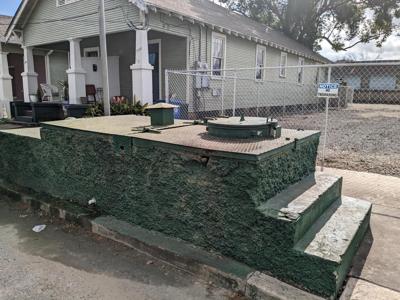For 300 years, mysteries of all sorts have abounded in the marshy patch of land between the Mississippi River and the shores of Lake Pontchartrain.
The strange green monolith crowding the sidewalk at the corner of Cohn and Lowerline streets in the East Carrollton neighborhood is one of the current ones.
Made of poured concrete and painted a gangrenous shade of olive drab, it’s about the length of a pickup truck, though perhaps only half as tall. From Lowerline, it looks like a front stoop divorced from its onetime home. From another angle, it suggests a parade-viewing platform.
But then there’s the manhole-sized hatch on the top, along with a pair of vents and what appears to be an antenna on a pole that reaches a good 20-something feet into the air, like something from “Lost.”
As it turns out, it’s a New Orleans Sewerage & Water Board project.
A little waste history
To be exact, it’s the entry to the subterranean Sewer Lift Station No. 1, a 120-year-old underground facility designed to pump waste from the city’s gravity-disadvantaged lower-lying areas.
In fact, it can boast of being one of the oldest S&WB facilities still in operation.
That body was established in 1899, only to merge four years later with the city’s Drainage Commission to put all New Orleans’ sewer, drainage and water duties under the purview of a single agency.
Before that, in the late 1800s, the city’s sewers — to the extent they existed — were almost exclusively of the surface-level variety (i.e., ditches of poop).
It wasn’t ideal.
“In the late (18)70s one of the principal New Orleans hotels discharged its sewage into the open gutter in front of its premises regularly at midnight, the watchman on duty in that vicinity being bribed to absent himself while this infraction of the law was committed,” historian John Smith Kendell wrote in his 1922 “History of New Orleans.”
A slow road
In 1880, the owners of the swanky St. Charles Hotel took it upon themselves to construct a private sewer line from their building at St. Charles Avenue and Common Street to the Mississippi River. “This,” Kendall wrote, “was the first main ever laid in New Orleans.”
It was around that time that a private company — the New Orleans Drainage & Sewerage Co. — was formed to undertake what was referred to as “the sewering of New Orleans.”
According to The Daily Picayune, the company was charged with establishing “a system of small water tight sewer pipes to receive sewage; this is to be carried to a reservoir situated at a convenient point, and thence forced by steam pumps into the river below the city, and below the low water mark.”
Work got off to a slow start, but the company made notable headway, laying some 5 miles of sewers within a few years. Unfortunately, that work was far costlier than expected. By 1895, the company was circling the bowl financially, prompting the city to buy its assets and take over the project.
With that, the sewering of New Orleans became a municipal project.
A reason to rush
Things reached a new urgency in 1897 when, after a nearly 20-year lull, yellow fever returned. That led to a rededication to sanitation, with voters in the city approving a millage to fund it.
By 1901, Sewer Lift Station No. 1 at Cohn and Lowerline was in place, with sewage from as far away as St. Charles and Carrollton avenues flowing in subterranean reservoirs to the station, where pumps lifted it 7 feet for its journey out of the city.
Additional improvements were undertaken in 1905, according to newspaper reports. More were taken in 1933.
It is still in operation today, part of a network of 1,450 miles of sewers running beneath the city, all served by 82 pump and lift stations. Seventy-nine of those stations are unmanned, including the Cohn Street facility.
Plans are on the books, however, to replace it with a modern, aboveground facility.
That work begun in earnest in mid-2022, when the S&WB awarded a contract to demolish two structures at the corner of Cohn and Lowerline to make room for the new pump station.
One of the structures slated for demolition was a 99-year-old building affectionately known as “the corner store,” prompting no shortage of outcry. It was to no avail. The building, which had been modified multiple times and was crumbling from years of neglect, was deemed to be of no historical value.
Today, it is gone, a vacant lot in its place, awaiting the start of construction. Once complete, the lines feeding the 120-year-old subterranean facility will be rerouted and the old poop-pumping station will be retired and removed.
And the mystery of Carrollton’s sidewalk monolith will be flushed away with it.
Sources: The Times-Picayune archive; Sewerage & Water Board of New Orleans; “A History of New Orleans,” by John Kendall; .
Know of a New Orleans building worth profiling in this column, or just curious about one? Contact Mike Scott at moviegoermike@gmail.com.
��


